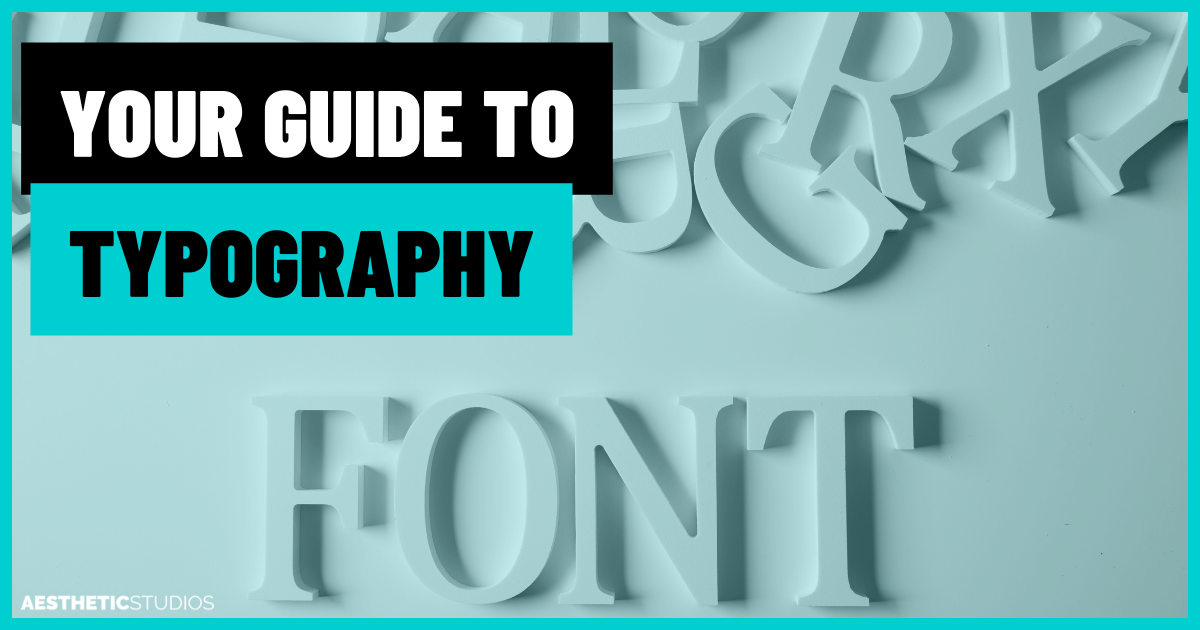Did you know that typography has been shown to have an impact on a buyer’s emotional state and their perception of brands (Source: CXL)? Typography has the power to shape perceptions, evoke emotions, and tell your brand story in a way that connects to your buyer. In this article, we’ll talk about exactly what typography is and how it can be applied in your business.
Why should you care about Typography in the first place?
Companies that prioritise design outperform their competitors by a significant margin.
In fact, a recent study showed that design-centric businesses experienced a 211% increase in shareholder value over a ten-year period (Design Management Institute).
By applying typography effectively to your graphic design, web design and UI design across your brand, you can influence your buyer’s emotional state and ultimately impact their buying decision.
While typography may have a subtle, subconscious impact, the effect exists, and it is important as a leader to understand how this can be applied to create a clear brand story and increase your bottom line.
In this article, you’ll learn:
- What is Typography?
- Why is Typography important in branding and design?
- Typography in branding and design
- How to choose the right typography for your brand
- How to apply typography in branding and design
What is Typography?
Typography, in the context of design and branding, refers to the art and technique of arranging typefaces in a visually appealing and effective manner.
It involves selecting and arranging various elements such as fonts, font sizes, letter and line spacing, and colours to create impactful written communication.
Changing these elements can have a significant impact on the look, feel and impact of a brand.
Let’s take a look at an example. The ‘Impact’ font is typically used for news headlines. Let’s take a look at the effect it has on the Bank of America website.
BEFORE THE CHANGE – ORIGINAL FONT
AFTER THE CHANGE – USING THE ‘IMPACT’ FONT
When the font is changed, the website immediately feels less trustworthy. That’s because this font is used specifically to capture attention – not to build trust.
As humans, we subconsciously associate certain fonts with different emotions. By understanding this, you can use fonts that elicit particular emotions to create a particular effect.
Remember, typography is selecting and arranging various elements including fonts, sizes, spacing, and colours to create impactful written communication.
You can see from the example above the impact that font can have. Now think about the sort of impact you can have on a buyer’s emotional state if you consider sizes, spacing, and colours.
Why is Typography important in branding and design?
Other than the fact that it impacts buyers emotions and therefore their buying decisions and your bottom line, there are also other reasons why typography is important in branding and design.Some of these reasons include:
- Visual Identity: Typography plays a crucial role in establishing a brand’s visual identity. The right choice of fonts can create a unique and recognisable brand personality, distinguishing it from competitors and making a lasting impression.
- Brand Perception: Typography influences how a brand is perceived by its audience. Different font styles evoke different emotions and convey specific qualities such as elegance, playfulness, or professionalism. Consistent typography helps reinforce brand values and messaging and ultimately impacts buyer emotions, which dictate their purchasing choices and your bottom line.
- Readability and Accessibility: Well-executed typography enhances the readability and accessibility of written content. Proper font selection, appropriate sizes, and adequate spacing contribute to clear and legible text, improving the overall user experience. Bottom line is, the easier it is to read, the more likely it is that your audience will read what you write and listen to you.
- Message Communication: Typography aids in effectively communicating messages. By utilising various typographic elements such as hierarchy, emphasis, and formatting, designers can guide readers’ attention, highlight important information, and create visual interest.
- Consistency and Cohesion: Consistent typography across different brand touchpoints, including websites, marketing materials, and packaging, enhances brand recognition because it helps maintain a consistent visual appearance. You want your audience to remember your brand, and in order to create that effect, you need a consistent look and feel – typography helps you achieve this..
Typography is clearly important in not only accurately sharing your brand story through visual elements, but also, to influence your buyer’s emotions, perceptions of your brand, and ultimately their buying decision, which impacts your bottom line.
Understanding typography’s definition and grasping its importance in branding and design lays a solid foundation for creating visually appealing and impactful designs.
The impact of Typography in branding and design
Typography plays an enormous role in the design process. In particular, typography should be considered for logo design, establishing brand recognition through cohesive design elements, and creative applications to stand out from the crowd.
Let’s take a look at some of these.
Typography in Logo Design
Typography design is a critical aspect of logo creation and visual identity development.
The choice of fonts, their arrangement, and overall design directly influence how a brand is perceived. A well-crafted typographic logo can instantly communicate a brand’s essence, values, and purpose.
By carefully selecting fonts that align with the brand’s personality, typography helps create a distinctive visual identity that sets your brand apart from your competitors.
Whether it’s a bold and modern typeface for a tech company or a refined and elegant font for a luxury brand, typography plays a key role in conveying the right message to the target audience.
Establishing Brand Recognition Through Cohesive Design Elements
When typography remains consistent across various brand touchpoints, such as advertisements, websites, and packaging, it helps create a cohesive and memorable brand experience.
Buyers associate certain fonts with specific brands, and consistent typography reinforces that association, making it easier for customers to recognise and remember the brand.
Moreover, typography helps convey brand personality and evoke desired emotions. Whether it’s a playful and whimsical font for a children’s product or a sleek and minimalist typeface for a high-end fashion brand,typography sets the tone and creates a visual language that resonates with the target audience.
Typography Art and Creative Applications
Typography extends beyond traditional branding and design applications, embracing the realm of art and creativity. Typography art showcases the artistic possibilities of letterforms, exploring experimental and innovative approaches to typography.
Artists and designers often utilise typography as a medium for creative expression, blending letters, shapes, and colours to create visually stunning compositions. Typography art can be found in various forms, including posters, illustrations, digital artwork, and installations. It pushes boundaries, inspires, and captures attention through its artistic interpretation of written communication, and this is something you can use to really stand out from the crowd.
By integrating typography design into logo creation, leveraging its power in establishing brand recognition, and exploring its creative applications in typography art, you can harness the full potential of typography to make a lasting impact on your audience and ultimately increase your bottom line.
How to choose the right Typography for your brand?
There are three steps to help you choose the right typography for your brand:
- Understand your brand and your target audience
- Selecting suitable fonts
- Explore Typography hierarchy and Kinetic Typography
Understand Your Brand and Target Audience
. Consider the following tips to ensure your typography resonates with your brand:
- Align with Brand Values: Identify the core values and personality traits that define your brand. Is it modern and innovative, traditional and reliable, or perhaps friendly and approachable? Choose typography that reflects these qualities and aligns with your brand’s overall aesthetic.
- Tone and Voice: Determine the tone and voice you want to portray through your brand’s communication. Typography can contribute to establishing a consistent tone, whether it’s formal, casual, professional, or playful. Ensure your typography choice supports the desired tone.
- Target Audience Research: Conduct thorough research on your target audience to understand their preferences, demographics, and cultural background. This insight will help you select typography that resonates with and appeals to your specific audience.
Selecting Suitable Fonts
Understanding different font categories and their characteristics is essential for making informed typography choices. Consider the following categories and recommendations:
- Serif Fonts: Serif fonts are known for their elegant and traditional appearance. They have small decorative lines at the ends of characters, called serifs. Serif fonts are often associated with reliability, authority, and tradition. Examples include Times New Roman, Georgia, and Baskerville.
- Sans-Serif Fonts: Sans-serif fonts have clean and modern designs without the serifs. They are versatile and widely used for their simplicity and readability. Sans-serif fonts often convey a sense of modernity, minimalism, and clarity. Popular options include Arial, Helvetica, and Futura.
- Script Fonts: Script fonts mimic handwritten or calligraphic styles, adding a touch of elegance, creativity, or playfulness. They are ideal for brands seeking a more decorative and personal feel. Examples include Brush Script, Lobster, and Pacifico.
- Display Fonts: Display fonts are highly styliSed and attention-grabbing, often used for headlines and emphasis. They come in various forms, from bold and futuristic to ornate and decorative. Use display fonts sparingly for maximum impact. Some notable examples include Impact, Bebas Neue, and Lobster.
- Additionally, consider utilising free font resources available online. Websites like Google Fonts, Adobe Fonts, and Font Squirrel offer a vast selection of high-quality fonts that can be used in both personal and commercial projects.
Exploring Typography Hierarchy and Kinetic Typography
One last thing to consider after you’ve chosen your font is the leading of your font and kinetic typography. Let’s take a look at both.
Leading Typography: Leading, pronounced “ledding,” refers to the vertical spacing between lines of text.
It plays a crucial role in establishing visual hierarchy and readability. Adjusting leading can create a more open or compact appearance, affecting how readers engage with the content. Experiment with leading to enhance the legibility and aesthetics of your typography.
Kinetic Typography: Kinetic typography involves animating text to create dynamic and engaging designs. It adds movement, timing, and visual effects to written words, making them more captivating and impactful.
Insert gif. This is an example of kinetic typography in action.
Kinetic typography finds extensive use in video productions, motion graphics, and digital advertisements. Explore online tutorials and resources to learn and implement kinetic typography techniques effectively.
How to apply Typography in branding and design?
How to apply Typography in Logo Design?
Brand Personality and Tone: Typography choices contribute to shaping the overall personality of a brand. Whether it’s a bold and assertive typeface or a playful and whimsical script font, the typography should align with the brand’s intended tone and evoke the desired emotional response from the audience.
Memorability and Recognition: A well-designed logo is memorable and instantly recognizable. Typography plays a crucial role in achieving this. Distinctive and unique typography can help a logo stand out and leave a lasting impression on viewers. Consider famous logos like Coca-Cola, Disney, or FedEx, where the typography itself has become iconic.
Legibility and Scalability: The legibility of typography is essential in logo design. It should be easily readable, even when scaled down to small sizes or used in different contexts. Selecting appropriate font styles, weights, and sizes ensures that the logo remains clear and recognizable across various applications.
Visual Hierarchy: Typography helps establish visual hierarchy within a logo design. By manipulating the size, weight, and placement of different typographic elements, designers can guide the viewer’s attention and emphasis key brand elements such as the company name, tagline, or symbol.
How to apply Typography in Graphic Design and Branding?
Consistency in typography is vital when it comes to brand collateral and marketing materials. From brochures and business cards to advertisements and packaging, typography plays a significant role in maintaining a cohesive brand identity.
Let’s explore how you can apply typography to yourbrand collateral and marketing materials.
- Brand Consistency: Select a set of fonts that complement your logo and brand identity guidelines, and consistently apply them to all materials. The key is to set guidelines and then maintain those. This consistency fosters brand recognition and reinforces the brand’s visual identity.
- Typography Hierarchy: Effective typography hierarchy guides the reader’s attention and helps communicate information effectively. Utilise typographic variations such as font size, weight, and colour to distinguish headings, subheadings, body text, and calls-to-action. Clear hierarchy enhances readability and ensures important messages are conveyed prominently.
- Alignment and Spacing: Pay attention to the alignment and spacing of typography within marketing materials. Proper alignment creates a sense of order and professionalism, while appropriate spacing between letters, words, and lines enhances readability and visual appeal.
- Brand Voice and Tone: Typography choices should align with the brand’s voice and tone in marketing materials. Whether it’s a formal and informative brochure or a vibrant and playful social media advertisement, the typography should reflect the intended mood and message.
How to Apply Typography in Design
In the digital realm, typography holds great importance in user experience, readability, and brand representation.
Consider the following aspects when incorporating typography into web and digital design:
- Readability and Responsiveness: Web typography should prioritise readability across various devices and screen sizes. Select fonts that render well on both desktop and mobile platforms, and ensure appropriate font sizes and line spacing to facilitate easy reading.
- Web-Safe Fonts and Web Fonts: To ensure consistent typography display across different browsers and devices, consider using web-safe fonts or utilising web font services such as Google Fonts or Adobe Fonts. These services offer a vast selection of fonts optimised for web usage.
- Information Hierarchy: Web and digital designs often involve presenting large amounts of information. Effective typographic hierarchy helps users navigate and comprehend content more easily. Utilise heading styles, subheadings, bullet points, and other typographic elements to structure information and guide users through the digital experience.
- Typography Errors to Avoid: In digital design, it’s important to be mindful of common typography errors. These include improper font pairing, excessive use of decorative fonts, poor contrast between text and background, and illegible typography at small sizes. By avoiding these errors, you can ensure optimal legibility and usability in your digital designs.
By leveraging typography effectively in logo design, graphic design, brand collateral, and web design, you can create a cohesive and impactful brand presence that resonates with your target audience while maintaining visual consistency across various touchpoints.
So, what’s next?
To sum things up, typography plays a crucial role in branding and design.
It goes beyond mere aesthetics – it is a powerful tool for clearly conveying your brand story, influencing buyer emotions, and increasing your bottom line.
Ultimately, if you want your brand to stand out, you need to be on top of typography. Once you’ve decided on your fonts, it’s important to then consider colour.
Colour also plays an enormous role in brand perception, influencing buyer emotions and establishing trust with your audience. If you want to be a leader in your space, then this is a must.
If you want to know how to use colour psychology to increase your bottom line, check out our article here.
Looking to create a logo or website for your business? Check out our pricing page here.



